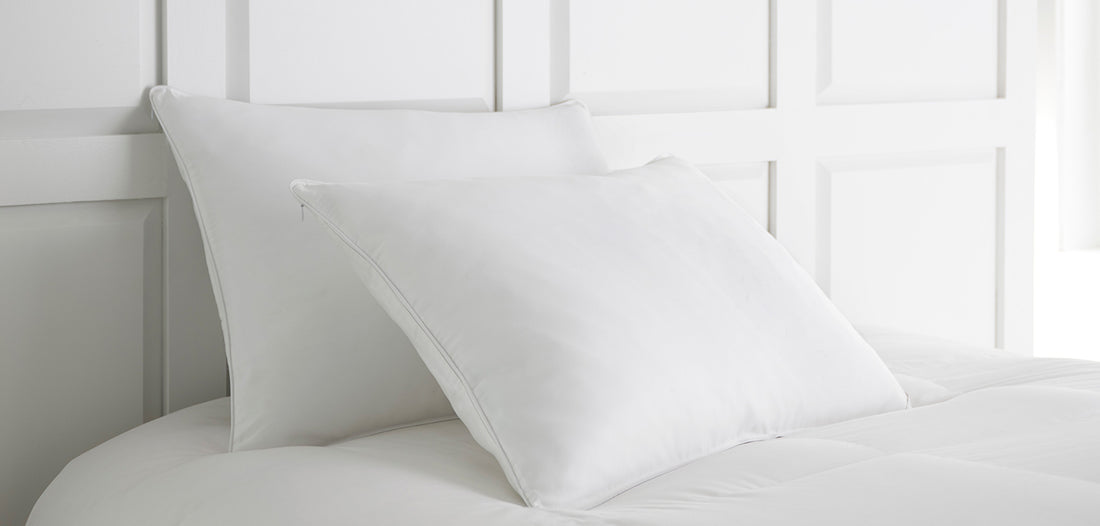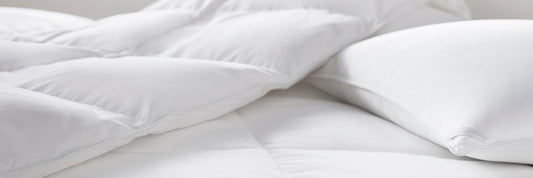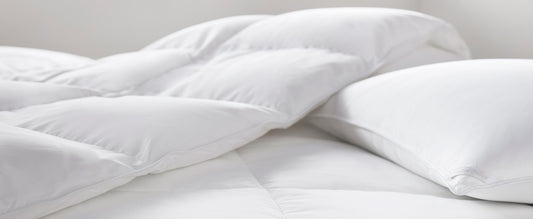Switching out your linens for allergy-free bedding can help you find relief if you suffer from allergies. Even if you keep your home spotless, dust mites, mold spores, and other pests still have a way of creeping into your room.
Research shows that it’s common for bedrooms to have multiple allergens. In one recent study, researchers looked at the dust vacuumed off thousands of bedroom floors and detected three to six allergens in 75% of the bedrooms.
Still, there are ways to protect your sleeping space. Here are four tips to keep your bedroom allergen-free.
Tip 1: Invest in an Allergy-Proof Mattress

If your allergies are disrupting your sleep, consider replacing your mattress. Old mattresses can be a breeding ground for dust mites, pet dander, mold, and mildew, triggering sneezing, coughing, congestion, and other allergic reactions.
High-quality mattresses made from allergen-resistant materials like cotton and wool can help relieve your symptoms. Hypoallergenic mattresses made from natural organic latex can also stop fungus, bacteria, dust mites, and other allergy-affecting microorganisms from collecting on your bed.
Tip 2: Choose Allergy-Free Bedding
Bedding can also be a primary allergen culprit in your bedroom. High-quality and allergy-free bedding can help reduce your exposure to allergens. Here are a few types of hypoallergenic bedding that can improve your sleeping environment.
Mattress Cover
Dust mites are one of the most common indoor allergens and one of the primary asthma triggers. They’re often found in mattresses as they feed on skin and hair particles, which people breathe in while sleeping. A fully enclosed and zippered mattress cover can create a protective barrier against dust mites, bed bugs, and other allergens. Look for a comfortable and well-suited cover that won’t change the feel of your mattress.
Mattress Topper
A mattress topper can add an extra layer of protection from allergens while enhancing your bed's overall feel. For example, our luxury wool mattress topper at Peacock Alley sets the stage for phenomenal sleep. Our topper is handmade by skilled artisans from the finest grade of 100% USA wool. It’s also non-allergenic, temperature-regulating, and environmentally safe.


Down Alternative Mattress Topper

Wool Mattress Topper
Allergy-Free Sheets & Bedding
Hypoallergenic sheets have tightly woven fabric to minimize gaps where dust mites, mold spores, and mildew spores tend to live. Allergy-free sheets and bedding made from natural materials like premium cotton, silk, wool, and bamboo are also naturally breathable and prevent moisture from settling in and breeding more allergens.
Duvets
When choosing a comforter or duvet, opt for a down-alternative fill. Peacock Alley’s silk-filled duvet offers excellent insulation while remaining breathable and airy. Made from 100% long-strand mulberry silk, this elegant bedding offers a natural hypoallergenic duvet for sleepers with sensitive skin and allergies.
For a more down-like sleeping experience, our Dacron® duvet offers a polyester fill that features luxuriously fine and lofty hypoallergenic fibers.
Pillows & Pillowcases
Hypoallergenic pillows help prevent allergen buildup. Some of the best options include pillows filled with natural latex, memory foam, wool, polyester, microfiber, or a down alternative. The outer shell of the pillow is also a critical factor if you have allergies. Look for fabric that is tightly woven together to keep out dust and allergens. Some of the best pillow covers include cotton, silk, bamboo, or Tencel.
Consider investing in breathable luxury pillowcases that wick away moisture while you sleep. Like a mattress cover, a pillow protector can add an extra layer of protection.
Tip 3: Frequently Clean Your Bedding
When choosing bedding for your home, opt for linens that are easy to clean. Frequently washing your sheets, pillowcases, and blankets will keep allergens from accumulating. Hot water and heat also help to kill dust mites and remove dirt, sweat, skin cells, and oil buildup. But you’ll want to follow your bedding’s care instructions closely for the best results.
Tip 4: Allergy-Proof Your Bedroom

In addition to using allergy-free bedding, here are a few other things you can do to keep your bedroom free of allergens.
Vacuum regularly - Vacuum your room with a HEPA filter at least once a week if you have carpet or live with pets. For best practices, vacuum early in the day so the dust settles before you nod off to sleep at night.
Minimize clutter - Keep your bedroom clutter-free to make your space easier to clean so dust and allergens don’t build up.
Keep pets out - Make your bedroom a pet-free zone, or at least keep them off your bed to minimize your exposure to pet dander.
Avoid heavy curtains - Instead of heavy drapes that trap dust, use washable curtains or blinds.
Run an air purifier - An air purification system with a HEPA filter can help remove airborne allergens from your bedroom.
Shower before bed - Rinsing off before crawling under your covers can keep pollen and other allergens out of your bed. Avoid sleeping with wet hair so the moisture doesn’t cause your pillow to grow mold.
Use a humidifier - If you live in a hot climate, run a humidifier in your bedroom so the humidity levels stay between 30% and 50%. Keeping your bedroom cool and below 77 degrees Fahrenheit can also help keep dust mites at bay.
Luxury Allergy-Free Linens at Peacock Alley
Not getting enough sleep because you’re coughing or sneezing throughout the night can affect your health. Investing in Peacock Alley’s allergy-free bedding can help you get better rest.
From down-alternative duvets to hypoallergenic sheets and pillowcases, we’re committed to helping you make your bedroom a sneeze-free sanctuary of comfort and class. Experience the Peacock Alley difference with our luxury hypoallergenic linens today.



















